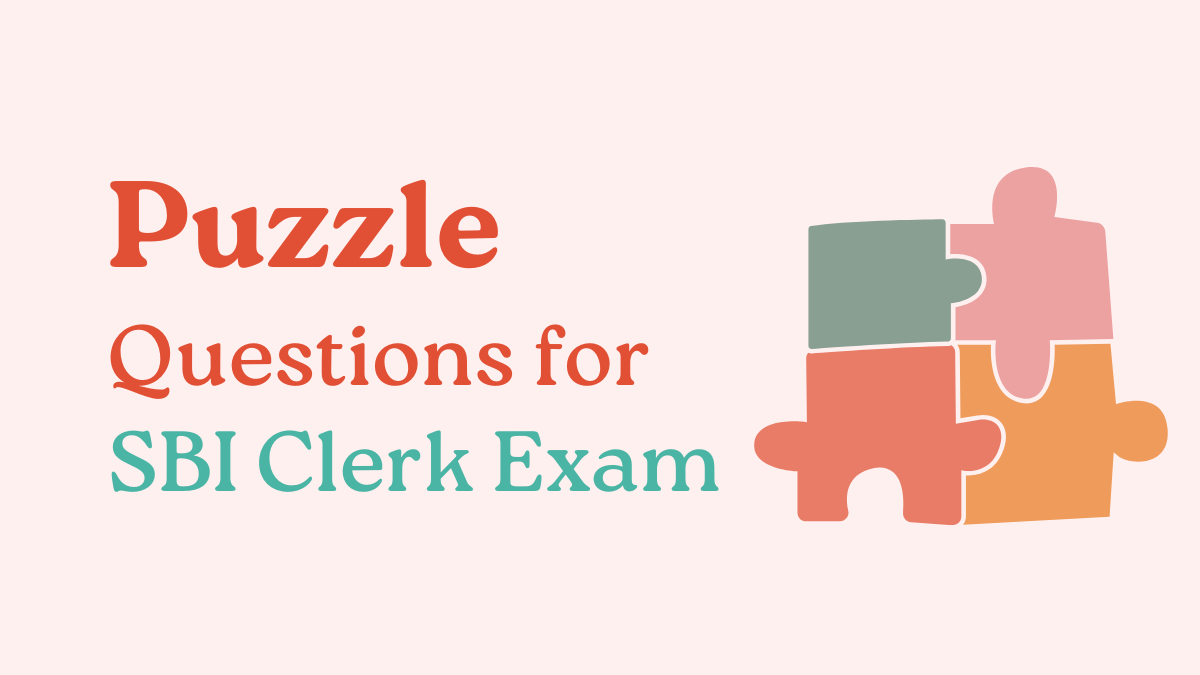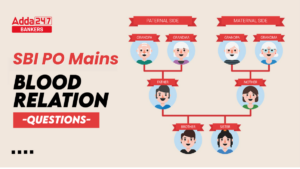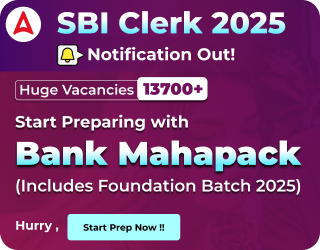Table of Contents
The Puzzle section is a crucial part of the reasoning ability test, where candidates are required to use logical thinking and problem-solving skills to find solutions. It typically involves seating arrangements, blood relations, directions, or other scenarios that require candidates to arrange or categorize information in a systematic manner. This article presents a set of puzzle questions for the SBI Clerk exam, as these types of questions are highly effective for preparation.
Puzzle Questions for SBI Clerk Exam
Practicing different types of puzzle-solving strategies and honing the ability to quickly analyze and organize information will significantly improve candidates’ efficiency in answering puzzle questions. With regular practice, candidates can develop the ability to identify key clues and solve puzzles in a time-efficient manner.
Below are the different types of puzzle questions commonly found in the SBI Clerk exam 2025. By practicing consistently, candidates can improve their ability to think logically, identify relevant information, and confidently solve these questions in the exam.
Directions (1-5): Study the following information carefully and answer the given questions.
Seven persons A, B, C, D, E, F and G have exam on seven different days of the same week starting from Sunday to Saturday. More than three persons has exam before E. G has exam before D and only two people has exam between them. C has exam immediate before A and none of them has exam on Monday. B has exam immediate before F. The number of persons has exam between F and G is less than number of persons has exam between D and A.
Q1. Who has exam on Monday?
(a) A
(b) B
(c) C
(d) D
(e) None of these
Q2. Who has exam just before F?
(a) A
(b) B
(c) C
(d) D
(e) None of these
Q3. How many persons have exam in between B and C?
(a) More than three
(b) One
(c) Two
(d) Three
(e) No one
Q4. Who has exam on Saturday?
(a) A
(b) B
(c) C
(d) D
(e) None of these
Q5. Who has exam just after E?
(a) A
(b) B
(c) C
(d) D
(e) None of these
Directions (6-10): Study the following information carefully and answer the given questions.
Amongst Six friends, P, Q R, S, T and U, each got different marks in the examination. T score more marks than U and P. R score more marks than U but less marks than S. P does not score marks that is an odd number. S score marks that are an odd number. S score more marks than T and does not score highest marks. R does not score less than T. The one who scored the minimum marks scored 29 marks and the one who scored the highest, scored 80 marks.
Q6. Who scored the lowest marks?
(a) P
(b) U
(c) S
(d) Q
(e) R
Q7. Who among the following Person has scored third highest marks?
(a) Q
(b) R
(c) T
(d) S
(e) Either (b) or (c)
Q8. If T score 60 marks than what may be the score of R?
(a) 56
(b) 81
(c) 68
(d) 89
(e) 59
Q9. What is possible score of S?
(a) 76
(b) 88
(c) 98
(d) 87
(e) None of these
Q10. Who among the following persons score more than P and less than S?
(a) R
(b) Q
(c) T
(d) Both (a) and (c)
(e) S
Directions (11-15): Study the following information and answer the given questions.
There are six boxes having different weight. Each box contains different number of candies- 2, 3, 4, 5, 6 and 1 but not necessarily in the same order. R contains more candies than M and R’s weight more than O, which contains odd number of candies. Box N contains 4 candies. P weighs more than only O. M weighs more than Q and N, but less than R. Box Q contains 2 candies and Q’s weight is more than N. The difference between the number of candies of box M and N is 1 and Box M contains more than 3 candies.
Q11. Which of the following box contains highest number of candies?
(a) R
(b) Q
(c) O
(d) M
(e) None of these
Q12. Which of the following box is third heaviest box?
(a) P
(b) O
(c) R
(d) Q
(e) None of these
Q13. What is the difference between number of candies between box R and Q?
(a) 3
(b) 1
(c) 4
(d) 2
(e) None of these
Q14. Which of the following box is heavier than N but lighter than M?
(a) O
(b) Q
(c) R
(d) P
(e) None of these
Q15. How many boxes are lighter than Q?
(a) One
(b) Two
(c) Three
(d) More than Three
(e) None
Directions (16-20): Answer the questions based on the following information.
There are ten shelves in a cupboard such that the bottommost shelf is numbered as 1, just above it is numbered as 2 and so on till the topmost shelf is numbered as 10. Eight gift boxes are placed in these shelves such that two shelves are vacant. (Note: Two consecutive shelves are not vacant).
There is one box placed below box B. There is two shelves gap between box B and box P which is placed just below the vacant shelf. Box Q is placed above box P at an even numbered shelf but not at the topmost shelf. One box is placed between box Q and box C. Box S is placed just below box A but above 2nd numbered shelf. Box A doesn’t place at the topmost shelf. Sum of the shelf number of box R and box Q is equal to the shelf number of box D.
Q16. How many boxes are placed between box A and box R?
(a) None
(b) One
(c) Two
(d) Three
(e) Four
Q17. Which of the following box is placed just above box Q?
(a) Box D
(b) Box S
(c) Box R
(d) No box
(e) None of these
Q18. How many boxes are placed below box P?
(a) One
(b) Four
(c) Three
(d) Two
(e) Five
Q19. What will be the sum of the shelf number of box B and box S?
(a) 6
(b) 7
(c) 5
(d) 4
(e) None of these
Q20. Which of the following shelf is vacant?
(a) Shelf10
(b) Shelf 5
(c) Shelf 8
(d) Shelf 7
(e) Both shelf 7 and 5
Solutions
Solutions (1-5):
Sol.
| Day | Person |
| Sunday | G |
| Monday | B |
| Tuesday | F |
| Wednesday | D |
| Thursday | E |
| Friday | C |
| Saturday | A |
S1. Ans. (b)
S2. Ans. (b)
S3. Ans. (d)
S4. Ans. (a)
S5. Ans. (c)
Directions (6-10):
Sol. ![]()
S6. Ans. (b)
S7. Ans. (b)
S8. Ans. (c)
S9. Ans. (e)
S10. Ans. (d)
Solutions (11-15):
Sol. R (6)>M (5)>Q (2)>N (4)>P (1/3)>O (1/3)
S11. Ans. (a)
S12. Ans. (d)
S13. Ans. (c)
S14. Ans. (b)
S15. Ans. (c)
S16. Ans. (c)
Sol.

S17. Ans. (a)
Sol.

S18. Ans. (b)
Sol.

S19. Ans. (b)
Sol.

S20. Ans. (d)
Sol.

| Related Post | |
| SBI Clerk Exam Date 2025 | SBI Clerk Reasoning Questions |
| SBI Clerk Previous Year Papers | SBI Clerk Cut Off |
| SBI Clerk Salary | SBI Clerk Syllabus |




 Important Blood Relation Questions for S...
Important Blood Relation Questions for S...
 Seating Arrangement Questions for SBI PO...
Seating Arrangement Questions for SBI PO...
 Inequality Questions for Bank Exams
Inequality Questions for Bank Exams





